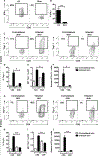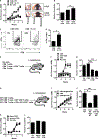CD8+ T Cells Lack Local Signals To Produce IFN-γ in the Skin during Leishmania Infection
- PMID: 29367210
- PMCID: PMC6178231
- DOI: 10.4049/jimmunol.1701597
CD8+ T Cells Lack Local Signals To Produce IFN-γ in the Skin during Leishmania Infection
Abstract
Resolution of leishmaniasis depends upon parasite control and limiting inflammation. CD4+ Th1 cells are required to control parasites, whereas CD8+ T cells play a dual role: they promote Th1 cell differentiation but can also increase inflammation at the site of infection as a consequence of cytolysis. Although CD8+ T cells taken from leishmanial lesions are cytolytic, in this study, we showed that only a few CD8+ T cells produced IFN-γ. Correspondingly, only low levels of IL-12 and/or IL-12 mRNA were present in lesions from infected mice, as well as patients. Addition of IL-12 increased IFN-γ production by CD8+ T cells isolated from leishmanial lesions, suggesting that a lack of IL-12 at the site of infection limits IFN-γ production by CD8+ T cells. To determine whether CD8+ T cells could promote resistance in vivo if IL-12 was present, we administered IL-12 to Leishmania-infected RAG mice reconstituted with CD8+ T cells. IL-12 treatment increased the ability of CD8+ T cells to make IFN-γ, but CD8+ T cells still failed to control the parasites. Furthermore, despite the ability of CD8+ T cells to promote immunity to secondary infections, we also found that CD8+ T cells from immune mice were unable to control Leishmania in RAG mice. Taken together, these results indicate that lesional CD8+ T cells fail to make IFN-γ because of a deficit in IL-12 but that, even with IL-12, CD8+ T cells are unable to control Leishmania in the absence of CD4+ T cells.
Copyright © 2018 by The American Association of Immunologists, Inc.
Figures






Similar articles
-
Requirements for the maintenance of Th1 immunity in vivo following DNA vaccination: a potential immunoregulatory role for CD8+ T cells.J Immunol. 2000 Jul 15;165(2):915-24. doi: 10.4049/jimmunol.165.2.915. J Immunol. 2000. PMID: 10878366
-
T cell response in murine Leishmania mexicana amazonensis infection: production of interferon-gamma by CD8+ cells.Eur J Immunol. 1993 May;23(5):1181-4. doi: 10.1002/eji.1830230532. Eur J Immunol. 1993. PMID: 8097471
-
Acute IL-4 Governs Pathogenic T Cell Responses during Leishmania major Infection.Immunohorizons. 2020 Sep 18;4(9):546-560. doi: 10.4049/immunohorizons.2000076. Immunohorizons. 2020. PMID: 32948646 Free PMC article.
-
[Immunopathology of American tegumentary leishmaniasis].Acta Cient Venez. 1998;49(1):42-56. Acta Cient Venez. 1998. PMID: 10205916 Review. Spanish.
-
The role of the innate immune response in Th1 cell development following Leishmania major infection.J Leukoc Biol. 1995 Apr;57(4):515-22. doi: 10.1002/jlb.57.4.515. J Leukoc Biol. 1995. PMID: 7722408 Review.
Cited by
-
Post kala-azar dermal leishmaniasis: A threat to elimination program.PLoS Negl Trop Dis. 2020 Jul 2;14(7):e0008221. doi: 10.1371/journal.pntd.0008221. eCollection 2020 Jul. PLoS Negl Trop Dis. 2020. PMID: 32614818 Free PMC article. Review.
-
Host-Directed Therapies for Cutaneous Leishmaniasis.Front Immunol. 2021 Mar 26;12:660183. doi: 10.3389/fimmu.2021.660183. eCollection 2021. Front Immunol. 2021. PMID: 33841444 Free PMC article. Review.
-
Leishmania Lipophosphoglycan Triggers Caspase-11 and the Non-canonical Activation of the NLRP3 Inflammasome.Cell Rep. 2019 Jan 8;26(2):429-437.e5. doi: 10.1016/j.celrep.2018.12.047. Cell Rep. 2019. PMID: 30625325 Free PMC article.
-
NKG2D promotes CD8 T cell-mediated cytotoxicity and is associated with treatment failure in human cutaneous leishmaniasis.PLoS Negl Trop Dis. 2023 Aug 21;17(8):e0011552. doi: 10.1371/journal.pntd.0011552. eCollection 2023 Aug. PLoS Negl Trop Dis. 2023. PMID: 37603573 Free PMC article.
-
Identification of molecular mechanisms causing skin lesions of cutaneous leishmaniasis using weighted gene coexpression network analysis (WGCNA).Sci Rep. 2023 Jun 17;13(1):9836. doi: 10.1038/s41598-023-35868-0. Sci Rep. 2023. PMID: 37330553 Free PMC article.
References
-
- Scott P, and Novais FO. 2016. Cutaneous leishmaniasis: immune responses in protection and pathogenesis. Nature reviews. Immunology 16: 581–592. - PubMed
-
- Scott P, Natovitz P, Coffman RL, Pearce E, and Sher A. 1988. Immunoregulation of cutaneous leishmaniasis. T cell lines that transfer protective immunity or exacerbation belong to different T helper subsets and respond to distinct parasite antigens. The Journal of experimental medicine 168: 1675–1684. - PMC - PubMed
-
- Liew FY, Millott S, Parkinson C, Palmer RM, and Moncada S. 1990. Macrophage killing of Leishmania parasite in vivo is mediated by nitric oxide from L-arginine. Journal of immunology 144: 4794–4797. - PubMed
Publication types
MeSH terms
Substances
Grants and funding
LinkOut - more resources
Full Text Sources
Other Literature Sources
Molecular Biology Databases
Research Materials

